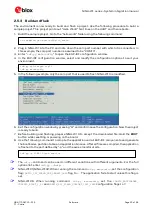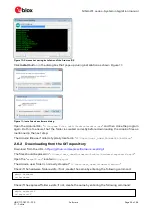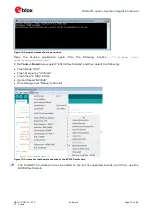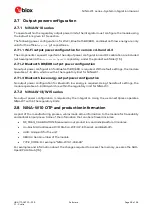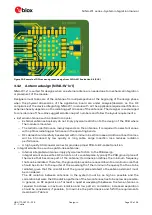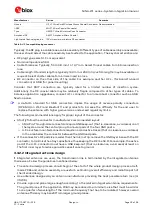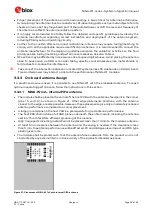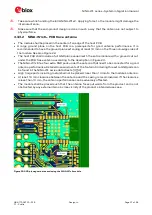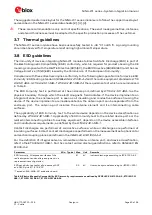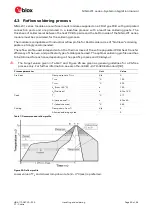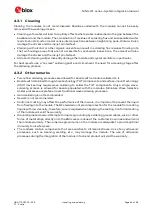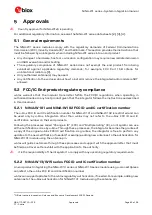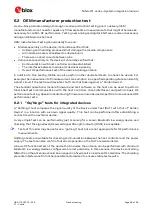
NINA-W1 series - System integration manual
UBX-17005730 - R15
Design-in
Page 35 of 54
C1 - Public
Manufacturer
Series
Remarks
Hirose
U.FL® Ultra Small Surface Mount Coaxial Connector Recommended
I-PEX
MHF® Micro Coaxial Connector
Tyco
UMCC® Ultra-Miniature Coax Connector
Amphenol RF
AMC® Amphenol Micro Coaxial
Lighthorse Technologies, Inc.
IPX ultra micro-miniature RF connector
Table 5: U.FL compatible plug connector
Typically, the RF plug is available as a cable assembly. Different types of cable assembly are available;
the user should select the cable assembly best suited to the application. The key characteristics are:
•
RF plug type: select U.FL or equivalent
•
Nominal impedance: 50
Ω
•
Cable thickness: Typically, from 0.8 mm to 1.37 mm. Select thicker cables to minimize insertion
loss.
•
Cable length: Standard length is typically 100 mm or 200 mm; custom lengths may be available on
request. Select shorter cables to minimize insertion loss.
•
RF connector on the other side of the cable: For example, another U.FL. (for board-to-board
connection) or SMA (for panel mounting)
Consider that SMT connectors are typically rated for a limited number of insertion cycles.
Additionally, the RF coaxial cable may be relatively fragile compared to other types of cables. To
increase application ruggedness, connect U.FL connector to a more robust connector such as SMA
fixed on panel.
☞
A de-facto standard for SMA connectors implies the usage of reverse polarity connectors
(RP-SMA) on Wi-Fi and Bluetooth
®
end products to increase the difficulty for the end user to
replace the antenna with higher gain versions and exceed regulatory limits.
The following recommendations apply for proper layout of the connector:
•
Strictly follow the connector manufacturer’s recommended layout:
o
SMA Pin-Through-Hole connectors require GND keep-out (that is, clearance, a void area) on all
the layers around the central pin up to annular pads of the four GND posts.
o
U.FL. surface mounted connectors require no conductive traces (that is, clearance, a void area)
in the area below the connector between the GND land pads.
•
If the connector’s RF pad size is wider than the micro strip, remove the GND layer beneath the RF
connector to minimize the stray capacitance thus keeping the RF line 50
Ω
. For example, the active
pad of the U.FL. connector must have a GND keep-out (that is, clearance, a void area) at least on
the first inner layer to reduce parasitic capacitance to ground.
3.3.2.2
Integrated antenna design
If integrated antennas are used, the transmission line is terminated by the integrated antennas
themselves. Follow the guidelines mentioned below:
•
The antenna design process should begin at the start of the whole product design process. Self-
made PCBs and antenna assembly are useful in estimating overall efficiency and radiation path of
the intended design.
•
Use antennas designed by an antenna manufacturer providing the best possible return loss (or
VSWR).
•
Provide a ground plane large enough according to the related integrated antenna requirements.
The ground plane of the application PCB may be reduced to a minimum size that must be similar
to one quarter of wavelength of the minimum frequency that has to be radiated; however overall
antenna efficiency may benefit from larger ground planes.



